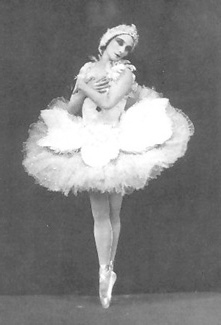 Marie Taglioni is most famous for her role in La Sylphide, in which she debuted this new style of dancing. David Barber's summary of the ballet: "La Sylphide tells the story of a young Scotsman named James who's about to get married to a woman he's not sure he loves. (She's his cousin and her name's Effie, neither of which may have helped.) The night before their wedding, he falls asleep and dreams of a beautiful winged fairy, a sylphid or sylph, who flies down and tries to lure him away. He follows her into the forest, but thanks to an evil spell by the neighborhood wicked witch, her wings fall off and she dies. At the end of the ballet, some of her sister sylphs fly down to carry her away, leaving James alone in the woods while Effie goes off to marry someone else entirely. Bummer." (Taken from Barber's Tutus, Tights, and Tiptoes: Ballet History as it Ought to be Taught-apparantly really cheap on Amazon).
Marie Taglioni is most famous for her role in La Sylphide, in which she debuted this new style of dancing. David Barber's summary of the ballet: "La Sylphide tells the story of a young Scotsman named James who's about to get married to a woman he's not sure he loves. (She's his cousin and her name's Effie, neither of which may have helped.) The night before their wedding, he falls asleep and dreams of a beautiful winged fairy, a sylphid or sylph, who flies down and tries to lure him away. He follows her into the forest, but thanks to an evil spell by the neighborhood wicked witch, her wings fall off and she dies. At the end of the ballet, some of her sister sylphs fly down to carry her away, leaving James alone in the woods while Effie goes off to marry someone else entirely. Bummer." (Taken from Barber's Tutus, Tights, and Tiptoes: Ballet History as it Ought to be Taught-apparantly really cheap on Amazon). Marie Taglioni dancing the role of the Sylphide. The new technique of dancing on pointe helped convey the otherworldiness of the fairies, as they seemingly floated across the stage.
Marie Taglioni dancing the role of the Sylphide. The new technique of dancing on pointe helped convey the otherworldiness of the fairies, as they seemingly floated across the stage.Picture by Don McMurdo, Australian ballet, Swan Lake
But the most famous ballets are the three Tchaikovskys- Sleeping Beauty, Swan Lake, and The Nutcracker. The combination of plot, music, costumes and scenery together with dance make all of the above instant classics. It's so unfortunate that both fairy tales and ballet have become culturally associated with little girls, and become something that every girl is interested in and then "grows out of." Ballet is a beautiful and incredibly difficult art form- in fact, few professions (if any...) require the amount of discipline and commitment demanded from a professional ballet dancer.

Hi Kristin, I am so happy I found your blog, I love it. I agree that fairy tales shouldn't only be associated with little girls.
ReplyDeleteBlanca
http://blog.blancadance.com